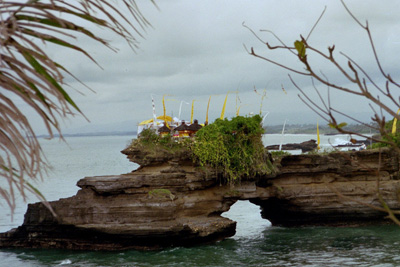
Picture postcard views like this are commonplace in Bali. Images of green terraced hillsides, temples great and small, arresting roadside craft shops, and uncrowded white sand beaches are but a few of the reasons why visitors are returning to the island after the senseless bombings in 2002 that killed so many people. In Kuta where the horrifying explosions occurred, a Hindu shrine stands unharmed by the tragedy while the surrounding area has been razed to the ground. Rather than be angry for the desecration of their peaceful island, the Balinese gathered in prayer for those who perished. Today, there is a memorial of flags representing the countries whose citizens lost their lives in the bombings. Local businesses are struggling back from the economic hardship posed by the loss of visitors.
Prayer is intrinsic in Balinese culture which is deeply rooted in the Hindu religion. The pura or temple is an important institution in the daily life of the people. This is where they worship, celebrate life and send their dead to the afterlife. Every village has at least three temples, each dedicated to one of the Hindu Trinity - Vishnu, the Preserver of LIfe, Brahma who is the Creator and Shiva, the Destroyer.
With thousands of temples in Bali, it is difficult to decide which ones to visit during a short stay. But Pura Tanah Lot has arguably the most dramatic setting. It is perched on top of a rocky promontory in southwestern Bali. It is practically floating on the sea at high tide. Tanah Lot means earth and sea, quite apropos given its location. When it is low tide, it is possible to walk to the islet and climb up to the temple. Also at Tahan Lot is Batu Bolong, a rocky outcrop straddling land and sea, like a protective arm cradling a cozy beach. It has an arched opening carved by the ocean over time. Several shrines sit on the edge of the rock.
We happened to visit during their New Year festival. This celebration takes place more frequently when the Pawukon Balinese calendar system is employed. (A Pawukon year has 210 days.) It was a lively scene with colorful streamers moving gently in the breeze. Men garbed in white shirt and pants and white turban called "udeng" were praying underneath one of the tents. Women arrived with their offerings balanced on their head. They wore a sarong tied with a sash, required for all women (including visitors) who enter the temple. A whiff of incense burning and gamelan music playing in the background further heightened the heady and exotic ambience.
There are many deities in the Hindu religion. The Pura Ulun Danu in Bratan is a temple dedicated to Dewi Danu, the goddess of the waters and source of fertility. It has a lakeside setting with Mt. Batur in the distance as its backdrop. It is often cloaked in mist lending it an ethereal appearance. Within the temple grounds are fine examples of meru, a multi-tiered black thatched pagoda. Merus have an odd number of roofs up to a maximum of eleven. The royal temple of Taman Ayun in Mengwi has an impressive line up of merus in its inner courtyard. Together they constitute the "skyscrapers" of the village.
Everyday we discovered palm leaf trays of offerings to the gods in the most unexpected places in Bali. Some contained flowers and betel, others fruit and rice flour cookies, and during the festival, we saw more elaborate offerings, all of them attractively arranged. No matter the content of these offerings, the Balinese are always trying to please their gods and their ancestors. This is why Bali and its people are blessed with beauty and serenity.
* * *

